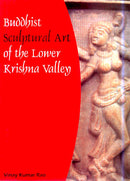Krishna is one of the most prominent river of peninsular India.It forms a large and fertile land. The convenient navigational approach to sea through Krishna helped in flourishing number of urban settlements like Amaravati, Nagarjunakonda, Goli, Jaggayepetta, Chezarla, Ghantasala, Gummadidurru, Bhattiprolu. The river also encouraged the rulers and traders of this region to influence the polity, economy and culture through maritime relations in far East Asian region.The political and economic stability attained during six centuries from 300 BC to 300 AD helped the inhabitants in motivating to offer sizable amount of donations in order to establish Buddhist embellishments. The region was occupied by both Mahasanghikas and Mahisasaka sect of Buddhism for long time which encouraged large monastic and laity activities in this region. Hence consequently an impressive number of Stupas and Viharas were established in this region. The stupas of lower Krishna region provides a good number of representations related to Buddhism in accordance to primary objective of Buddhist sculptural art but also projects an extensive glimpse of contemporary life of inhabitants. This work Buddhist Sculptural Art of the Lower Krishna Valley intends to present most important Buddhist narratives of lower Krishna region at one place. The work intends to make a comparative study of Buddhist narratives and their repetitive presentations at various Buddhist sites. The symbolic and anthropomorphic presentations of Buddha, manifestation of Buddha and related Deities, important scenes from life of Buddha, Jataka stories are main themes which are given due importance in the volume. The work also attempts to reconstruct the contemporary life of people living in this region during first three centuries of AD.
Description
Krishna is one of the most prominent river of peninsular India.It forms a large and fertile land. The convenient navigational approach to sea through Krishna helped in flourishing number of urban settlements like Amaravati, Nagarjunakonda, Goli, Jaggayepetta, Chezarla, Ghantasala, Gummadidurru, Bhattiprolu. The river also encouraged the rulers and traders of this region to influence the polity, economy and culture through maritime relations in far East Asian region.The political and economic stability attained during six centuries from 300 BC to 300 AD helped the inhabitants in motivating to offer sizable amount of donations in order to establish Buddhist embellishments. The region was occupied by both Mahasanghikas and Mahisasaka sect of Buddhism for long time which encouraged large monastic and laity activities in this region. Hence consequently an impressive number of Stupas and Viharas were established in this region. The stupas of lower Krishna region provides a good number of representations related to Buddhism in accordance to primary objective of Buddhist sculptural art but also projects an extensive glimpse of contemporary life of inhabitants. This work Buddhist Sculptural Art of the Lower Krishna Valley intends to present most important Buddhist narratives of lower Krishna region at one place. The work intends to make a comparative study of Buddhist narratives and their repetitive presentations at various Buddhist sites. The symbolic and anthropomorphic presentations of Buddha, manifestation of Buddha and related Deities, important scenes from life of Buddha, Jataka stories are main themes which are given due importance in the volume. The work also attempts to reconstruct the contemporary life of people living in this region during first three centuries of AD.
Payment & Security
Your payment information is processed securely. We do not store credit card details nor have access to your credit card information.


